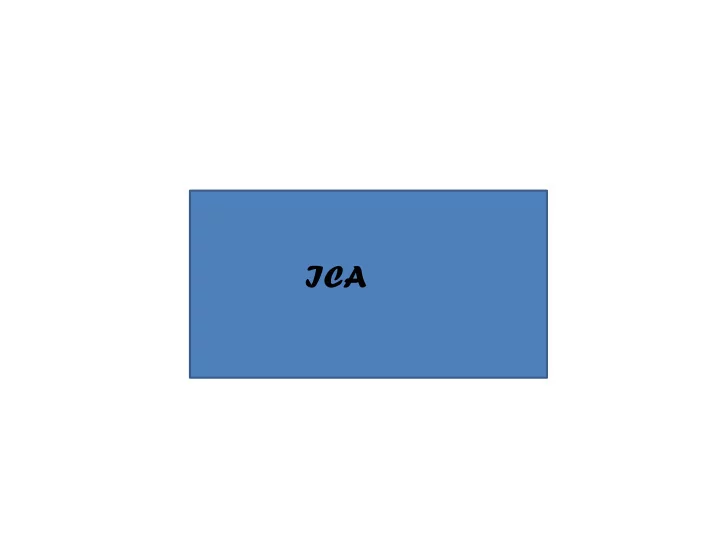

ICA
ICA: 2-D examples x 1 s 1 Observations Sources x 2 s 2 x = As = X A 2*2 X 2*n S 2*n
Independent Components Analysis X a S a S a S 1 11 1 12 2 1 p p X a S a S a S X AS 2 21 1 22 2 2 p p X a S a S a S p p 1 1 p 2 2 pp p If we knew A we could solve for the sources S But we have to solve for both We will look for a solution that will make S independent
PCA and ICA
X = AS • Getting a simpler form • We can always express A by SVD as UΣV T • U and V are orthonormal and Σ is diagonal • (we don’t know any of them) • So now X = UΣV T S • Taking the covariance matrix of the data: • XX T = UΣV T S S T VΣU T • We can assume that SS T = I • They are independent, therefore uncorrelated. • We can assume all of length = 1 • This is just scaling; we can scale S and A
• X = AS • A = UΣV T (the SVD of A) • X = UΣV T S • XX T = UΣV T S S T VΣU T with SS T = I • XX T = UΣ 2 U With the same U, Σ we used for A above • XX T is known, so we can find the U, Σ of A from the data • (by diagonalizing XX T = U Λ U T )
ICA procedure • Looking for X = AS with S independent • Start by whitening X: • X' ← Σ -1 U T X Do PCA, then: • In the new data solve for X’ = VS • Both V,S unknown, but V is rotation, and S are independent. • Search over rotations and test for independence • For a given V, S is easy to obtain, we need some measure of independence
Whitening the data v 2 v 1 Perform PCA Re-scale the coordinates by their variance ICA: Final step – look for rotation that will make S as independent as possible
Testing for Independence • Suppose that a source produces variables (x 1 y 1 ) (x 2 y 2 ).. • It is straightforward to test if they are correlated or not by Σx i y i = 0 • In practice, Σx i y i > ε • How to test independence? • Several methods, describe briefly one.
1-D projection
Testing independence p(y) p(x) p(x,y) = p(x) p(y)
• In principle for each pair x i y j verify that p(x i y j ) = p(x i ) p(y i ) • We have many pairs, how to use them together in an efficient test • We look at the two distributions p(x,y) and q(x,y) = p(x)p(y) • We want to test if they the same (or very close) • How to compare two distributions?
Two distributions – how different are they?
Testing for Independence • Use the KL divergence: Kullback-Leibler • KL(p||q) = Σ [ p log ( p/q)] • Non-negative, it is 0 only iff they are the same. • In our case • KL [p(x y) || p(x) p(y)] = Σ [p(x y) log (p( x,y)/p(x) p(y))] = • Σp (x,y) log p(x,y) - ( Σp (x,y) log p(x) + Σp (x,y) log p(y)) • = -H(p(x,y)) +[H(p(x)) + H(p(y))] • • ΣH i - H • H is constant, minimize ΣH i (marginal distribution after rotation)
v 2 v 1 Final step: optimize iteratively over rotation. For each rotation project the data on the axes and measure Hi of the projections.
Technical difficulties: • Minimizing ΣH i on all the axes • Non-convex, complex, minimization • Estimating entropy H, requires enough samples, sensitive to outliers • Various algorithms to optimize the numeric process • FastICA ( Hyvärinen ), Proceeds one component at a time, then combines them
Equivalent Criterion • Rotation that maximizes H – ΣH i also maximizes the “non -Gaussianity ” of the transformed data. • • Non-Gaussianity (‘ negentropy ’): as the Kullback-Leibler divergence of a distribution from a Gaussian distribution with equal variance. • • Non-gaussianity is also measured by Kurtosis • • Family of algorithms that maximize Kurtosis rather than marginal entropies
Kurtosis Non-Gaussianity: Kurtois should be far from 3 A family of algorithms that use Kurtosis rather than marginal entropies
On Whitening the Data • An important step in general, additional comments: • The data matrix XX T can be expressed as: UΛU T • • Whitening X is: • X W = Λ -1/2 U T X • • We can check: • T = Λ -1/2 U T X X T U Λ -1/2 X W X W • • Substituting XX T • • Λ -1/2 U T UΛU T U Λ -1/2 = I
On Whitening the Data • Whitening: X W = Λ -1/2 U T X • Regularization: • Λ -1/2 is a diagonal matrix with 1/(sqrt λi ) on the diagonal • This is regularized to 1/(sqrt λ i + ε) • ZCA (zero-phase whitening) • • Whitening is non-unique. • Any rotation will leave it whitened (next slide) • • Taking in particular U from the data matrix: • • X ZCA = U Λ -1/2 U T X • • From all whitened X W , this is the closest to the original X.
v 2 v 1 After whitening, added rotation leaves the data whitened
Next: Performing the ICA on image patches: • The “independent components” of natural scenes are edge filters • Bell and Sejnowski Vision Research 1997
Recommend
More recommend